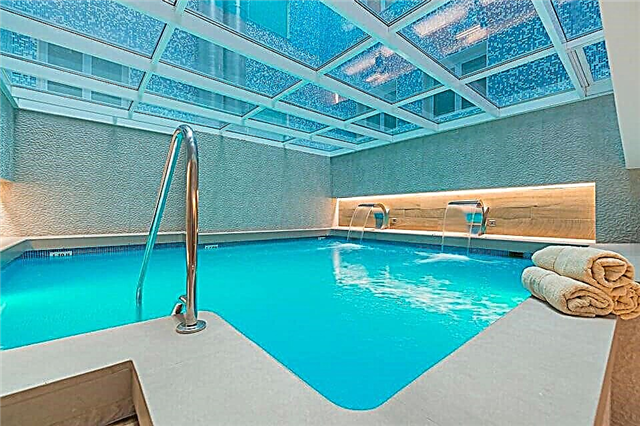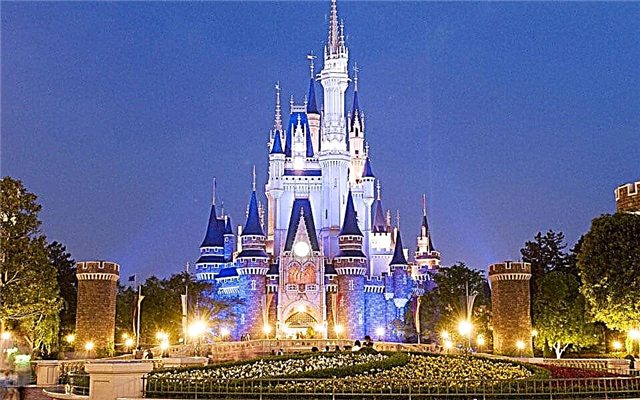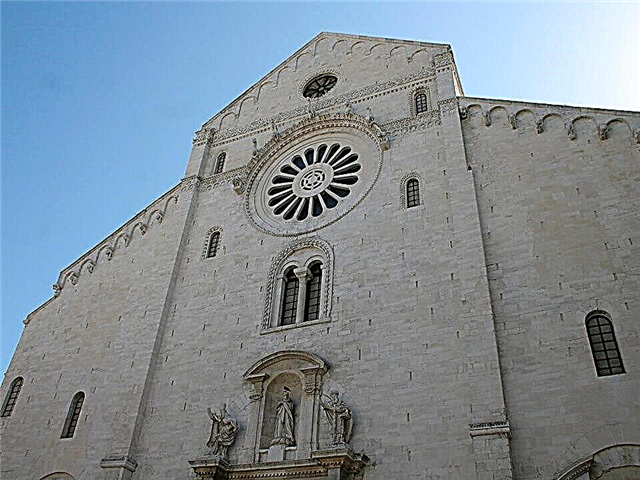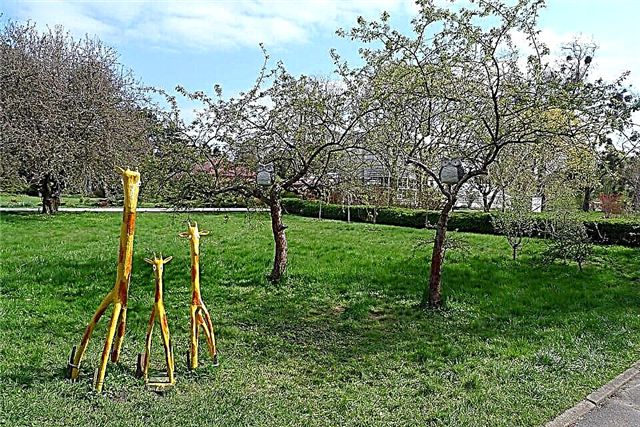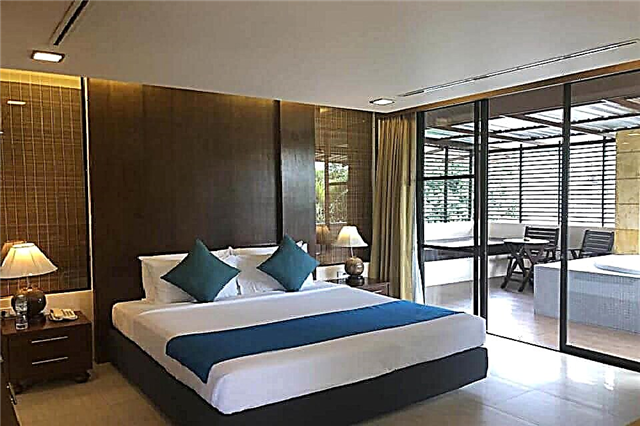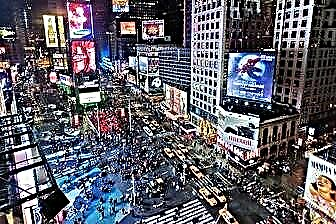The appearance of the main Belgian city and the capital of the European Union reflects the 1000-year history of its existence, captured in cultural, historical and architectural monuments. They are the embodiment of Dutch restraint and French grace, since Brussels happened to be the capital of Burgundy and part of the Netherlands. Among the interesting objects of the city, popular with tourists, are the parks of Brussels, which delight with their landscape beauty and originality.
Brussels park

In the center of the city there is a vast green oasis (more than 13 hectares) - the Brussels Park. If you mentally turn to the Middle Ages, then at this place you can imagine the impenetrable dense Suan forest. The trees, standing in a solid wall, became a reliable barrier for the Germanic tribes, who were striving to the south. A large area of forest surrounded the palace residence of the Dukes of Brabant. After the fire that destroyed the buildings, they were not rebuilt.
And only at the end of the 18th century. (1776-17883) engaged in clearing and improvement of the surrounding area. The creation of the landscape and cultural object was supervised by the French Varanda and Zinner, so the brainchild of their project is decorated in the French style. The entire area is clearly demarcated by alleys, paths and platforms. The wide central alley is directed to a crystal clear pond with a fountain.
Shady alleys radiate from the reservoir in 3 rays, each of which leads to the main Brussels sights: Prestolnaya Square, the Royal Palace and the Palace of Justice. One cannot but admire the variety and beauty of trees, shrubs and herbaceous plants, numerous statues, musical pavilions, lakes and ponds. Themed parties and celebrations are organized here on weekends.
Park Mini-Europe

On the territory of Brupark (outskirts of Brussels) in 1989 a kind of open-air museum "Mini-Europe" was opened. It contains miniature copies of 350 famous landmarks from 80 European cities. Despite the fact that Brupark itself is very interesting to visit, the bulk of tourists tend to come here precisely because of the amazing object. "Mini-Europe" is located at the foot of a hill with a grandiose model of the atom - Atomium, installed on it, in comparison with which the copies seem like midgets next to Gulliver.
The genuine accuracy and filigree craftsmanship of creating magnificent copies is amazing. All the smallest details and touches are meticulously reproduced in accordance with the originals. Ancient castles, temples, fortresses, town halls, street blocks, fragments of famous squares are displayed accompanied by visual and sound effects. Leaning Tower of Pisa, Westminster Palace, picturesque houses of Copenhagen, the Eiffel Tower, etc.
To make it more realistic, many figures of people are placed: janitors, gardeners, church members, spectators around the sports arena. The model of the old Seville arena is very impressive, on the stands of which there are 6,000 tiny "little men" painted by hand. Various types of transport in its evolution are presented. "Mini-Europe" makes an irresistible impression!
Brupark

This is one of the most popular parks in the city, where there are interesting entertainment facilities. Here people of all ages will find a lot of interesting things for themselves. The main attraction is the Mini-Europe park with models of famous buildings in 80 European cities. London Big Ben, Greek Acropolis, Leaning Tower of Pisa, Brandenburg Gate, Stockholm City Hall and other famous buildings will amaze with their believable views.
Impressive is the giant model of the atom - Atomium (1958), from the top of which you can observe the panorama of the city. The best place for children is the Oceade water park, with a year-round operation cycle and a constant temperature of 30 °. The 29 auditoriums of the IMAX cinema complex are a huge entertainment and educational platform for visitors. After sightseeing and walking around interesting places, you can go to the designer restaurant-bar "Village" and in the atmosphere of a typical European village relax and treat yourself to the masterpieces of national cuisine.
Laken Park

The huge palace and park complex was founded under King Leopold in 1900. The idea to create a place where structures reflecting the architectural and artistic styles of different countries would be erected came to the king after visiting the World Exhibition in Paris. He bought the exotic Japanese tower he saw there, which became the first object of the future Laken Park.
The park area is spacious green lawns, decorated with beautiful flower gardens, greenhouses, many paths and paths. You can endlessly admire the figuratively trimmed bushes, the openwork pagoda pavilion. But the main attractions of Laeken are true masterpieces of architecture. One of the masterpieces is the unique Japanese 6-level pagoda tower made entirely of wood without a single nail. The interior details of the structure were made by Japanese craftsmen in Tokyo and Yokohama to ensure that the pagoda is 100 percent authentic.
The Chinese pavilion (palace) is Laken's undoubted decoration. The two-level palace, built of red bricks, is decorated with wooden ornaments inside and out. They were masterly performed by Shanghai masters. At first it was planned to open an aristocratic restaurant in the pavilion, but the idea did not materialize. For several years there were expositions of the Trade Museum, 45 years (1947-89) the building was empty. Now the halls of the palace house a solid collection of ancient Chinese porcelain.
Motel One Brussels
Brussels
10 minutes walk from Grand Place

Steigenberger wiltcher's
Brussels
Located on the famous Avenue Louise

Hotel Hubert Grand Place
Brussels
Occupies a historic building in the city center

Abbey of Cambrai

A charming atmospheric corner located in the Bois de la Cambrai river valley, the ancient abbey of Cambrai. At this place in the 13th century. there was a Cistercian nunnery. The monastery, which existed before the French Revolution, was stripped of its status. In subsequent years, the monastery buildings alternately housed a military hospital, a cotton processing factory, and a soldier's school. After a grand restoration in the 20th century. the territory of the abbey was decorated with pretty lawns, alleys, flower beds.
The renovated buildings shine with freshness and become very attractive objects. Their architecture mixed features of different styles, from the Gothic to the Renaissance. Today they house the parish church, the Belgian National Geographic Society and the School of the Arts. When visiting the Abbey of Cambrai, you can relax on cozy benches in the shade of trees or on the velvety green of the lawns.
Fiftieth Anniversary Park

The symbol of Belgium's independence and the pride of Brussels is the 50th Anniversary Park, the most popular among Brussels citizens. It was created on the site of a military training ground in honor of the 50th anniversary of Belgian independence. The garden-architectural complex was intended to demonstrate the economic power of the country at the World Exhibition, timed to coincide with the anniversary. The entrance to it is marked with a magnificent Triumphal Arch of a symbolic 50-meter height. All statues, sculptures and bas-reliefs decorating the arch illustrate great state events and symbolize different regions of the country.
The entire park area (about 30 hectares) has charming artificial lakes, cozy groves, and a mini-waterfall. One cannot but admire the bright flower beds with a kaleidoscope of flowers, shady alleys, green velvet lawns in English and French styles.Of great interest is the Temple of Human Passions - an unusual architectural structure in the Art Nouveau style.
Visits to the Automobile Museum, the Great Brussels Mosque, and the Royal War Museum are impressive. The design of all objects contains motives of patriotism: mosaics, frescoes, monuments reflect history. There are solemn parades of troops with a large crowd of people.
Botanical Garden

For the first time, the prototype of the botanical garden appeared in the city at the end of the 18th century, when exotic plants were planted on a small plot. On the initiative of venerable botanists, it was moved to another place with fertile soils. Lush groves, many open meadows attracted the organizers' attention, and the garden received a new development. But on the eve of World War II, almost all of the plantings were taken to the fields in the vicinity of the city of Meiss. Today, on Korolevskaya Street, there is a preserved section of the Botanical Garden.
30 sculptures made by local sculptors, lovely lawns for relaxation delight visitors with their views. The decoration of the floristic area is a glass greenhouse with a round rotunda, under the roof of which the Winter Garden is laid out. You can't take your eyes off the lush bloom of camellias and azaleas - they are so good. Interesting for visitors Workshop of Queen Elizabeth (grandmother of the Belgian King Albert II) Belgians and tourists like to relax on green lawns.
Petit Sablon Garden

In the central part of Brussels, next to the cathedral, there is a masterpiece of landscape and park art - a small rectangular square called the Petit Sablon garden. Created in 1890 on the site of an old cemetery, this charming architectural and floristic corner has become a real decoration of the prestigious Sablon quarter. Looking today at the extraordinary beauty of the design, you understand what a huge work of designers, florists, sculptors is invested in this miracle.
At the entrance, visitors are "greeted" by the murmur of jets, fountains, the center is decorated with magnificent flower beds, lawns - masterpieces of topiary art (giving various forms to shrubs by cutting). The entire picturesque area is surrounded by a metal lattice with 48 evenly alternating powerful pillars-pedestals. Each of them has bronze statuettes that immortalize representatives of various guilds of the Middle Ages. Watchmaker, roofer, plumber, lamplighter, pharmacist, etc. A visit to this lovely garden is aesthetic pleasure.
Suan forest

Once a huge forest area served as a reliable guard of the Belgian provinces from the conquerors - its thickets were so impassable. With the development of civilization, virgin forests were subjected to felling during the construction of roads, economic activities and the expansion of urban urbanization. But even today the forest covers part of the Brussels region, Flanders and Wallonia. The landscapes of the Suan Forest have been recreated in fiction and paintings by Flemish masters. The events that took place with the legendary Bayard, Ronald, Thiel Ulenspiegel unfold in the Suan wilds.
Belgians adore their forest and take great care of its flora and fauna. Rare species of shrubs and trees grow here, squirrels, wild boars, elks and other wild animals live. A sports school operates in a specially equipped area, where training in football, handball, and frisbee is held. They ride bicycles, ride horses, go jogging, and walk along cozy, well-maintained paths and paths. On the stocked lake, amateurs are sitting with fishing rods.
National Botanical Garden

The most extensive and rich in plant species (25 thousand species) garden area, occupying 93 hectares, is located in the vicinity of the city of Meise. On the picturesque territory there are ponds, the Royal Castle of the 12th century. - the main architectural landmark. Thousands of tropical plants collected from all over the world are collected in 30 themed greenhouses.
For example, in the Mediterranean greenhouse, the flora characteristic of this climatic zone is represented. There is the Greenhouse of monsoons, mountain rain forests, edible fruits, etc. Admire a large collection of orchids, the collection of predatory plants is amazing. The South American water lily amazes with its gigantic size, the leaf of which is able to hold a one-year-old baby.
A visit to the Botanical Garden will delight not only specialists, but also ordinary tourists. In addition to contemplating amazing exhibits, they admire the authentic view of the castle, the original greenhouse in the form of a crown, a charming lake, visit a souvenir boutique and a local restaurant.
Park of the Palace of Academies

A wonderful landscaped island with a small lake surrounds an old 3-storey building - Egmond Palace. It was erected in the first half of the 19th century. as a residence for William of Orange and the daughter of the Russian emperor Anna Pavlova, the prince's wife. Now the luxurious palace has been given to 5 state academies, and the adjacent territory is called the park of the Palace of Academies. A calm, quiet place disposes to contemplative walks among neat lawns, figured labyrinths of bushes, along perfectly groomed alleys.
Against the background of landscape delights, interesting sculptures and small statues, an elegant colonnade are installed here. Notable is the sculptural copy of Peter Pan, a fairytale hero invented by the English writer Barry. In addition to him, there are figurines of other famous literary characters and animals created by talented sculptors. In the cozy cafe you can have a snack, drink coffee or sit at one of the many benches.
Abbey of Rouge-Cloatre

In Brussels, a lot is connected with the Suan Forest, located in the vicinity of the city. Local dukes were engaged in royal hunting in it, settled around it in the 13-14 centuries. 18 monasteries. Only a small part of the monastic cloisters have survived to this day, including the Abbey of Rouge-Cloister. The monastery grew out of a small chapel and became famous by the 15th century. its extensive library, various workshops and production.
It is natural that in the 16th century. the abbey became the most authoritative and powerful among other monasteries. Then came the era of ruin and oblivion (17-18 c). Now, after partial reconstruction, the Rouge-Cloister is an interesting tourist attraction, where medieval authenticity coexists with stylized modernity. A farm, a mill house, a brewery, which lies in ruins, have survived from the previous buildings. The former refectory houses a restaurant with 17th-century interiors.
One wing of the building is adapted for art workshops; farm buildings are used for the maintenance of the estate. One cannot but be enchanted by the lovingly groomed territory of the abbey, hedges of trees and shrubs, ideal paths, openwork trellises. The Grünendahl arboretum with 400 forest plants is located in the surrounding area. The monastery building is a unique monument of Gothic architecture.
Mont de Art garden

Between the Royal Palace and the Grand Place is the Mont de Art square. When it was a densely populated quarter, but at the end of the 19th century, the buildings were demolished in preparation for the 1910 World's Fair. To amaze foreigners with something unusual, King Leopold II decided to organize the Hill of Arts in the vacated space. The implementation of the idea was entrusted to the landscape architect P. Vachero, who planned the "temporary" green area.
But the city dwellers fell in love with the monumental staircase with cascades of fountains on the hillsides, slender rows of trees, lawns and bright flower beds that all this beauty became permanent. Now many tourists believe that there is no more attractive place in Brussels than this cultural and landscape corner. There are Museums around: Fine Arts, Musical Instruments, Magritte Museum.Nearby stands the Church of St. James, a monument to King Albert is erected. A stunning view of the Old Town opens up from above.
Leopold Park

Not far from the building of the European Parliament on 10 hectares there is a very nice and cozy park area. It was redesigned as a park in 1880 to replace the Royal Zoo. On the territory, immersed in greenery, the buildings of the School of Trade. Solvay, Friends of Europe and Mason de Europa think tanks, Belgian Institute of Natural Sciences.
It's nice to move from the urban stone jungle to the green oasis of wildlife. In ponds overgrown with duckweed, waterfowl live: mallard ducks, moorhenes, swans, Egyptian geese. There is also a chicken coop and aviaries with parrots. Everywhere is cleanliness, well-groomed, there are toilets. Here you can have a great rest and have a snack, feed the birds, enjoy the peace and quiet. Under the crowns of old huge trees, lovely lawns overgrown with white daisies are a great place to relax.
Woluwe Park

The largest park in the Belgian capital, located at the intersection of Avenue Tervuren and Boulevard Suveren, occupies 71 hectares of area. It was created in 1986 for the 50th anniversary of the country's independence. The main factor in choosing the location was the successful natural landscape. Thanks to the valley of the Voluwe River (hence the name of the massif), several large ponds were built here. The coastal groves have become part of the parkland with the fauna inhabiting them. The ponds were populated with waterfowl: ducks, swans, Canadian geese, etc. Squirrels jump in the crowns of branched trees, and rabbits live in the dense grass.
Locals like to walk in Woluwe, especially parents with children. Children communicate with birds, feed them, observe animals. Dog owners walk their pets. But there are always a lot of people just walking along the water bodies. Cyclists ride along specially equipped paths, amateurs and professionals go in for jogging, and sedate couples walk. A wonderful oasis of flora and fauna not only pleases with its landscapes, but also benefits the health of the townspeople.
Joseph Park

Once upon a time, on the site of the current park site in the Schaerbek district, there was an old forest of natural origin Lintu. King Leopold II, spotting it in 1904, decided to ennoble the forest area and create a public place for the leisure of citizens. Under the leadership of Edmond Gallopin, the forest was cleared of dry forests, trees were pruned, and the area was ennobled. Landscape architects planned lawns, laid flower beds and flower beds.
The territory, granted by nature, was adorned with magnificent statues, over which the recognized sculptors of that time V. Rousseau, A. Desenfant and J. Lagat worked. For more than a century, the public park of Josapha has been pleasing visitors with a bizarre weaving of spreading crowns, various water reservoirs with bridges, cheerful bird tints and a peaceful atmosphere.
Oceade Water Park

This jungle-style water theme park is located in a busy tourist district, not far from the Atomium. It is the largest water park in Belgium with 14 different slides. Among them there are extreme slides (Hurricane, Cannonball, Barracuda); family attractions (Chameleon, Anaconda) and children's slides. Many indoor and outdoor wave pools, jacuzzis, different types of baths, saunas - the choice of entertainment is huge. From "Hurricane", extreme sportsmen fly 80 m in 7 seconds.
The pool with 3 types of waves "Caribbean Sea" is in demand: from light breeze to storm. You can swim in the outdoor pools even in winter - the water is heated in them. All reservoirs are equipped with terraces for relaxation. A Zen zone has been created for parents with children, equipped with a jacuzzi, a swimming pool with hydromassage, a mini-sauna and a terrace. While the children are swimming, parents can watch them from the panoramic Martinique bar. Full meals can be ordered at Pirates of the Caribbean Restaurant.
Elizabeth Park

Full of captivating charm, the landscape and park area, named after the beloved Queen Elizabeth, is located next to the Roman Catholic Church of Sacre Coeur. The majestic basilica is located on the top of the Kukelberg Hill, increasing its height by 100 m. In front of the sanctuary, there is a spacious green meadow, fenced on 2 sides by picturesque alleys, a living floristic hedge.
Mighty centenary trees, a variety of ornamental shrubs, cute lawns, numerous benches, antique lanterns create a calm, cozy atmosphere. Here you can relax your body and soul, breathe in ozone, plunge into the historical past. The townspeople come here with their pets, walk them under shady tents. Tourists do not bypass this corner to take a break from excursions.
Duden Park

Almost in the very center of the Belgian capital, it is amazing to see the beech groves of the Sonian Forest that have been preserved intact. They form the basis of the unusual Duden Park, which stretches over 23 hectares. Previously, these plots belonged to Forest Abbey, then the Duden family became the owner until 1900. Under Leopold II, the forest was transferred to the state.
The widow of the last representative Dudenov rented it until 1912, when the authentic place was opened for public use. Now the meadow expanses and glades have been mastered by children, athletes, football players. They go in for health jogging, walking, and a football team. Duden Park is an example of respect for nature, for natural forests.
Small Sablon Square

A small cozy garden, surrounded by an ornate wrought-iron fence, delights with its floristic content, sculptural decorations, the neighborhood of the Notre-Dame-du-Sablon cathedral. The official opening of the square took place in July 1890, and it got its name from the quality of the soil in this place - clay (sablon).
In the very center of the park there are statues of Counts Egmon and Horn, national heroes and patriots. They are surrounded by sculptures of 10 famous historical figures who played a significant role in the formation of the country. They glorified Belgium with their talents and work. Charming flower gardens, mini-fountains decorate the territory, making it picturesque and attractive.

